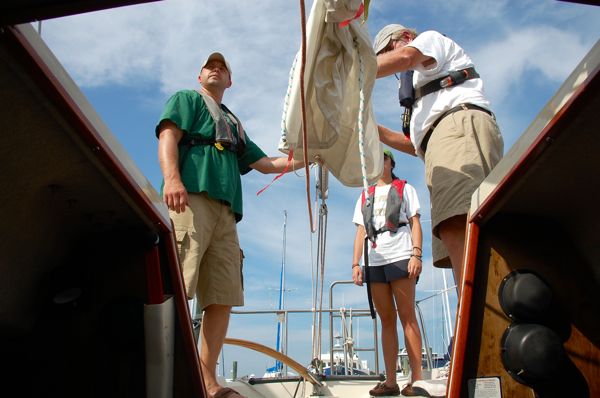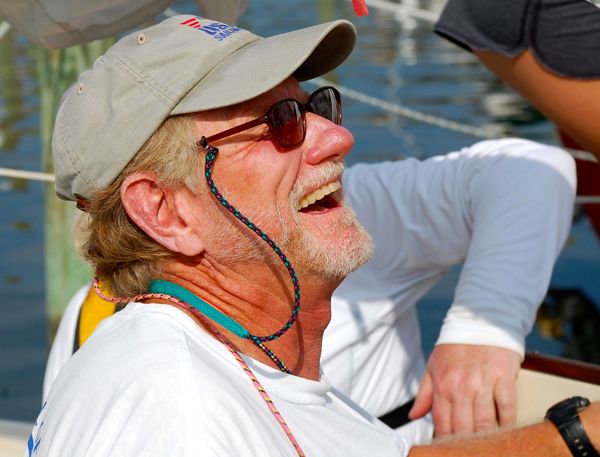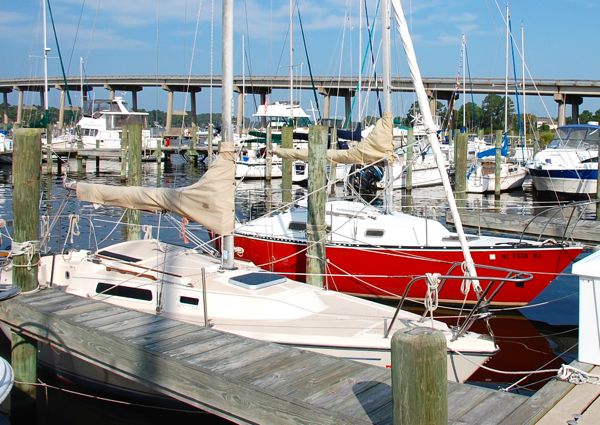It's Friday October 24, 2025
August 1, 2013
For 30 years, Oriental’s School of Sailing has taught students the difference between a sheet and a halyard and a bowline and a bow line. Hundreds of aspiring sailors have taken the course and learned a skill they can enjoy the rest of their days. Recently owner Chris Daniels talked about the school’s history as he knew it – how it came into being, what it does and how he got involved.He also shared some thoughts on the school’s future.
In the past year, Chris purchased The Silos restaurant in Oriental. That business is going well; it also consumes most of his time. So that he can focus on running one operation instead of two, he has decided it’s time to find the sailing school a new owner.
 Oriental’s School of Sailing students hoist the main sail aboard one of the school’s vessels, a C&C 24. Participants during this particular session hailed from New Bern to Boston.
Oriental’s School of Sailing students hoist the main sail aboard one of the school’s vessels, a C&C 24. Participants during this particular session hailed from New Bern to Boston.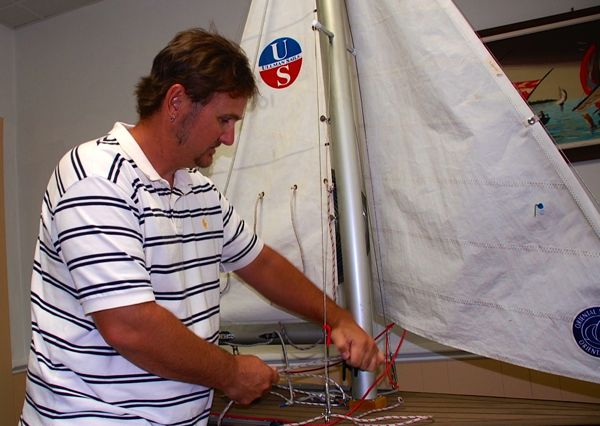 Sailing school owner Chris Daniels adjusts a line on a large scale model the school uses during classroom sessions. Skills learned in this controlled setting are later honed on the school’s sailboat fleet.
Sailing school owner Chris Daniels adjusts a line on a large scale model the school uses during classroom sessions. Skills learned in this controlled setting are later honed on the school’s sailboat fleet.Chris says the school’s story starts with boats bumping in to piers and a sailor named John Poole. In the late 1970s, John worked as dock master at a Whittaker Creek Marina. His job was to ensure the facility operated smoothly, vessels were properly secured and the docks were safe. Still there were unscheduled encounters between boats and piers. Chris says, “John was watching a lot of people crash in to the docks.”
John figured there had to be a better way.
Boat owners had noticed that John was a good sailor. He, in turn, thought he could teach them to become better captains. In the late 1970s, John started teaching people how to safely operate their boats. The fledgling business, which he ran with Grace Evans – starting on the deck of her home – took hold. In 1980 he incorporated the business as Oriental’s School of Sailing. Grace Evans would later establish her own sailing school.
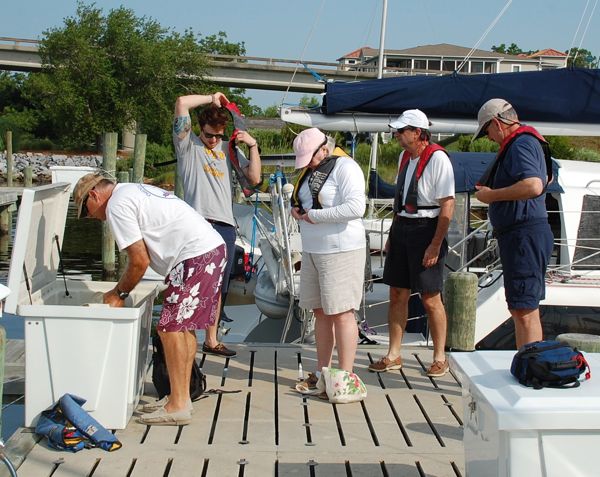 When it comes to sailing preps, some things never change. Lines need checking. Sails need prepping. Here, a recent group of school attendees don life jackets before boarding their vessels. The school’s on-water sessions are based out of Oriental Harbor Marina.
When it comes to sailing preps, some things never change. Lines need checking. Sails need prepping. Here, a recent group of school attendees don life jackets before boarding their vessels. The school’s on-water sessions are based out of Oriental Harbor Marina.While running the school, John met and married his wife Juliana. She became heavily involved in the school’s training program. Chris says, “it was really cool because it was a husband and wife team. So the girls could relate to the girls and the guys could relate to the guys.”
John’s sailing wasn’t restricted to small vessels. He taught aboard a 30-foot Pearson 303 and a similar sized Ericson. The school offered 7-day and weekend courses. Over the course of John’s ownership, the school occupied, among other locations, the Wit’s End building (located diagonally across from the Town Dock.)
The business prospered. John made good on his motto of “A Week of Instruction. A Lifetime of Adventure.” For two decades, the school taught students how to trim sails, navigate and pilot their craft safely back to shore. It launched a new generation of sailors – one week at a time.
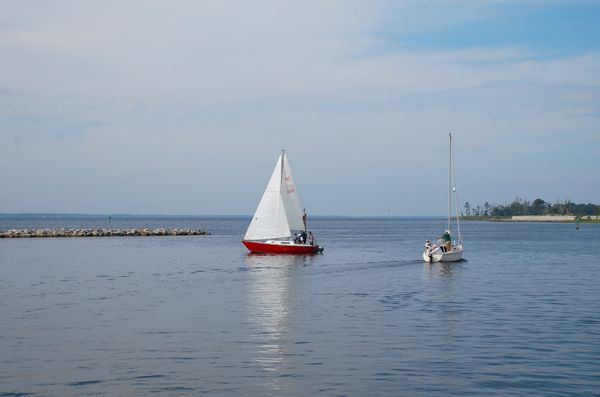 Two sailing school vessels – one motoring and one under sail – at the mouth of the Oriental anchorage. The breeze is more zephyr than brisk, a perfect time to practice light air techniques.
Two sailing school vessels – one motoring and one under sail – at the mouth of the Oriental anchorage. The breeze is more zephyr than brisk, a perfect time to practice light air techniques.In 1999, while John still owned the business, Chris visited Oriental for a weekend getaway. Accompanying him was his then bride Emily. They stayed at the Cartwright House Bed and Breakfast. They had no intention of buying a sailing school.
[page]
During their Oriental stay, Chris asked around what type of business could work in the village. Someone mentioned that John might be interested in selling his school. The two met. John parted with his business and Chris became the second owner of Oriental’s School of Sailing.
After Chris bought the business, John stayed on 4 months teaching him how to run it. Chris says that in the end, he largely copied John’s model.
It’s proven a solid decision. Since then, aside from varying course lengths and making minor curriculum adjustments, the operational model has stayed largely the same.
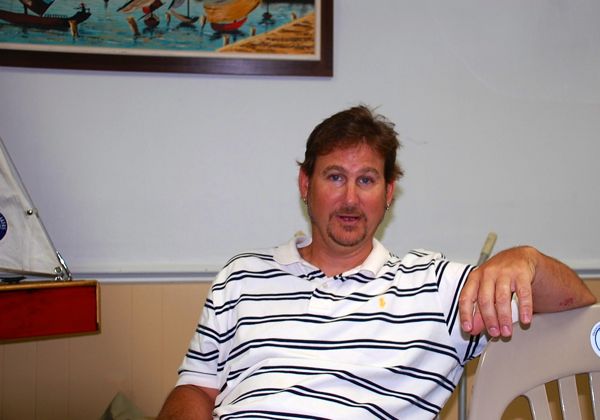 Chris taking a classroom break. Beneath the painting, the bow of the sailboat model used for explaining sail basics.
Chris taking a classroom break. Beneath the painting, the bow of the sailboat model used for explaining sail basics.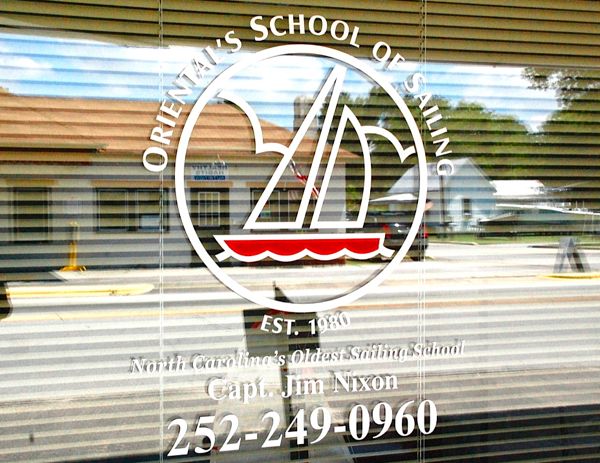 The sailing school’s entrance. Seen as a reflection across Broad Street is Georgie’s Hair Styling Salon.
The sailing school’s entrance. Seen as a reflection across Broad Street is Georgie’s Hair Styling Salon.The sailing school offers three programs taught over four-day and weekend courses. Programs are based on US Sailing principles and combine classroom with hands-on experience.
The classroom sessions take place at the sailing school’s headquarters on Broad Street. On-water sessions are conducted aboard sail boats berthed at the Oriental Harbor Marina. The lead instructor is US Coast Guard licensed captain Jim Nixon (Chris had this role until acquiring the restaurant).
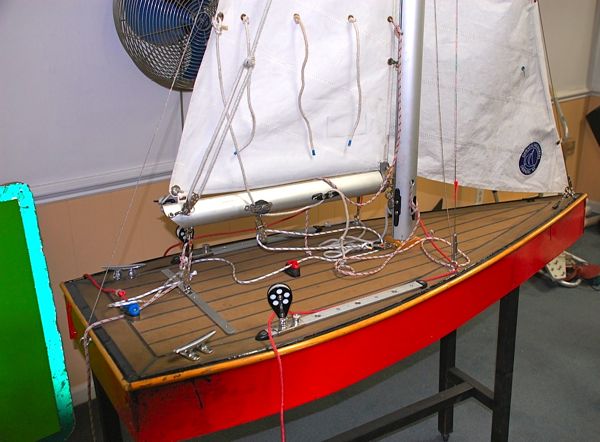 The school’s model sailboat. Jib, mainsail, upper shrouds, lower shrouds, spreaders, mast, boom and main halyard. They’re all there. Chris says he built the model, “after hurricane Isabel killed the old one.”
The school’s model sailboat. Jib, mainsail, upper shrouds, lower shrouds, spreaders, mast, boom and main halyard. They’re all there. Chris says he built the model, “after hurricane Isabel killed the old one.”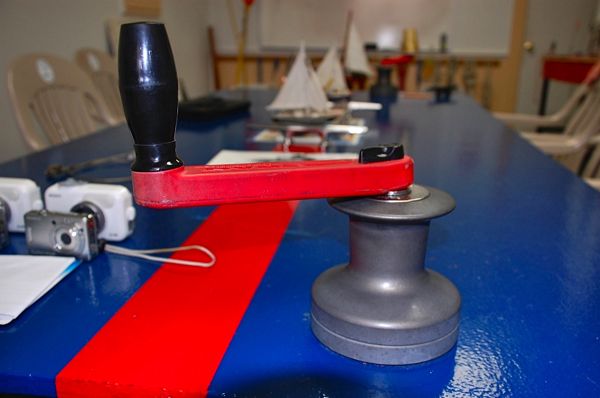 The school offers classes for up to 8 participants at a time. Here, a winch and handle are on display for closer inspection while, in an other part of the classroom….
The school offers classes for up to 8 participants at a time. Here, a winch and handle are on display for closer inspection while, in an other part of the classroom….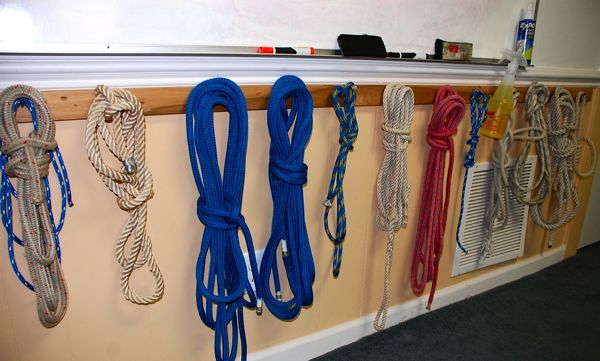 … lines in three-stand and braid await knots and bends.
… lines in three-stand and braid await knots and bends.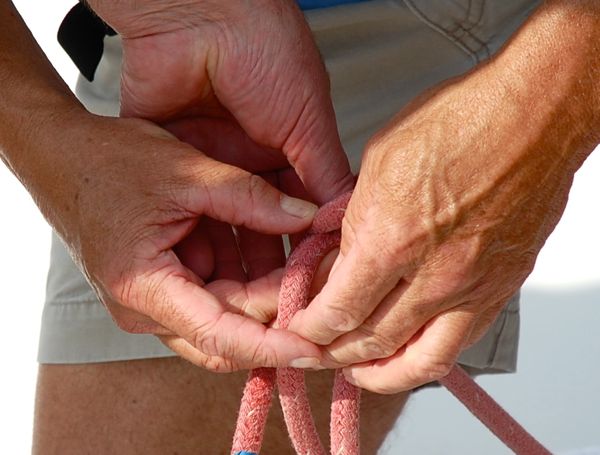 Helping hands. Classroom sessions teach students that the jib sheet is connected to the clew of the sail with a bowline knot. On the water, though, that’s easier said than tied. Here, an extra set of hands helps complete a bowline knot.
Helping hands. Classroom sessions teach students that the jib sheet is connected to the clew of the sail with a bowline knot. On the water, though, that’s easier said than tied. Here, an extra set of hands helps complete a bowline knot.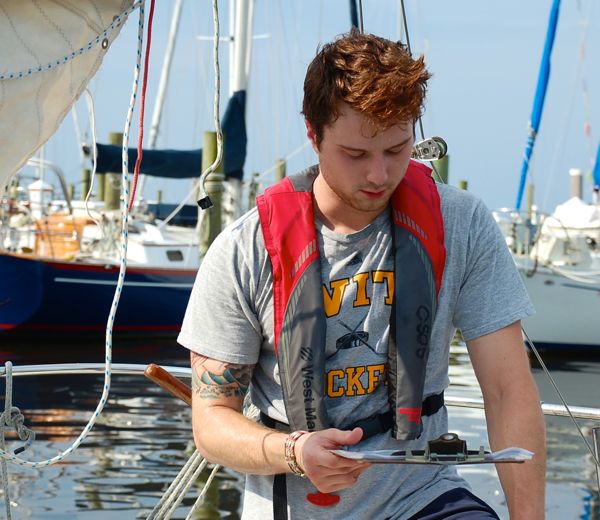 Sailing may enjoy a carefree reputation but to do it well, basics must be learned. Here, Jeremy Bost of Boston reviews a checklist for the C&C 24 he is skippering.Moments before backing the Cal 24 away from the dock. In a few seconds, her bow will be pointed toward open waters.Heading to the sailing grounds. Students motor the short distance from the Oriental Harbor Marina, where the sailboats are kept, to the sailing grounds off Oriental.Summer sail. In Pamlico County, the hottest months are known for light breezes. Here, a group of sailing students soaks the bow on a late-July outing. The day had started almost windless. As it wore on, enough of a breeze sprang up to fill out the Genoa and main sail nicely. (Jim Nixon photo)Head instructor Jim Nixon. Jim says he would be happy to work with the sailing school’s new owner.
Sailing may enjoy a carefree reputation but to do it well, basics must be learned. Here, Jeremy Bost of Boston reviews a checklist for the C&C 24 he is skippering.Moments before backing the Cal 24 away from the dock. In a few seconds, her bow will be pointed toward open waters.Heading to the sailing grounds. Students motor the short distance from the Oriental Harbor Marina, where the sailboats are kept, to the sailing grounds off Oriental.Summer sail. In Pamlico County, the hottest months are known for light breezes. Here, a group of sailing students soaks the bow on a late-July outing. The day had started almost windless. As it wore on, enough of a breeze sprang up to fill out the Genoa and main sail nicely. (Jim Nixon photo)Head instructor Jim Nixon. Jim says he would be happy to work with the sailing school’s new owner.Keel Boat Certification teaches beginners and novice sailors the skills confidently handle their own boats in coastal waters. Courses begin in a classroom where students learn sailing theory. A large model sailboat is used to help clarify sailing terms and techniques under controlled conditions.
Other topics – covered off and on the water – include sail trim, points of sail, docking and undocking under sail and power, basic seamanship, knots, and rules of the road.
The Coastal Navigation course teaches the the art of inshore navigation. This includes dead reckoning techniques, chart reading and position determination. Chris considers it a great course for sailors planning extended day trips and visiting new locations.
A basic powerboat course is also offered. It develops the skills and confidence necessary to safely skipper or crew a small powerboat in coastal waters
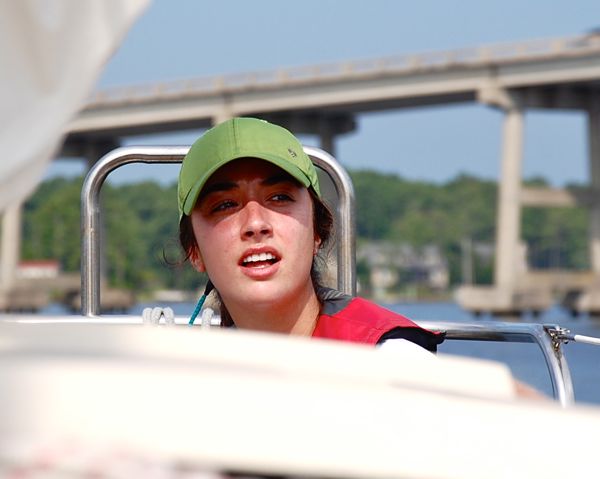 Emma Hancock of Winston-Salem checks her course as she maneuvers in front of the Oriental bridge. Emma is studying journalism at Chapel Hill University. She attended sailing school with her dad Drew who heard about the sailing program through a friend. Back on the dock her father…
Emma Hancock of Winston-Salem checks her course as she maneuvers in front of the Oriental bridge. Emma is studying journalism at Chapel Hill University. She attended sailing school with her dad Drew who heard about the sailing program through a friend. Back on the dock her father…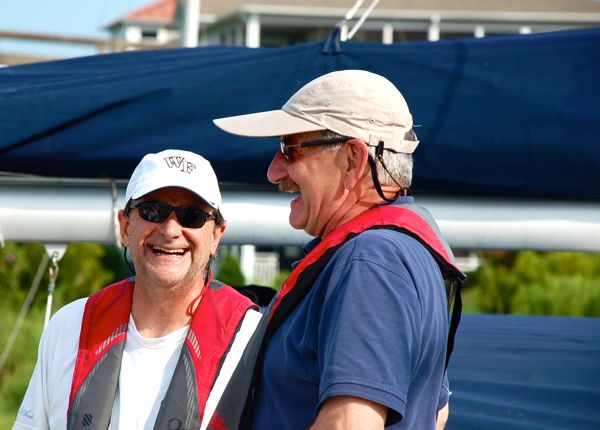 … Drew (L), who ended up sailing on another boat, enjoys a laugh with another sailor.
… Drew (L), who ended up sailing on another boat, enjoys a laugh with another sailor.After 14 years of teaching tacking, jibing and sail handling, Chris says it’s time to focus on a new venture. When he purchased The Silos restaurant, he had initially hoped to run both businesses. Chris recently remarried – both he and his new bride Kim agree Chris should focus on his career as restaurateur. The sailing school is for sale.
[page]
The sailing school’s sale includes a mix of tangibles and intangibles. First, there’s the school’s historic value. Chris says, “You’re getting a piece of Oriental… the Sailing Capital of North Carolina.” It is thought the program is North Carolina’s oldest continuously operating sailing school.
This has brand value – as do the school’s domain and website.
Also included in the sale are classroom supplies, computers, tables, two C&C 24 sailboats, engines and sails.
Sailing lessons are taught aboard C&C 24 sailboats. The keel boats are large enough to offer relatively stable sailing platforms. With their fin keels and spade rudders, they are still small and maneuverable enough to provide sailors with dinghy-like responsiveness.Chris is honest about the work involved in running a sailing school. His advice to a future owners is, “it definitely has to be a passion of yours.” The new owner, “has to live this life. It’s sail repairs, it’s engine repairs. It’s all kinds of repairs.”
People skills are vital. He says,“you have to love people because every week you meet so many cool different people. You could have a scientist. Or physicians or stars… Every single week, you don’t know who you’ll meet.”
Above all, the new owner must have strong feelings toward sailing. “You’ve got to love the sport. You’ve got to love the wind.”
For the right person or persons, though, it could be an ideal fit – an established sailing business in North Carolina’s Sailing Capital. All just a few tacks from the Pamlico Sound and Neuse River. A couple, if each worked as a sailing instructor, could be ideal.
It could prove a chance for the school’s next owner, as founder John Poole hoped, to embark on a lifetime adventure – one week at a time.
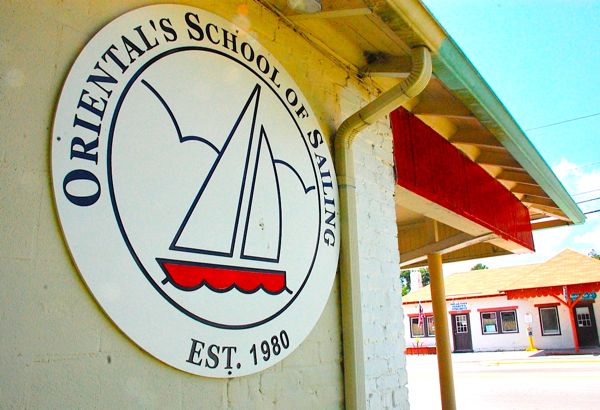 Oriental’s School of Sailing. The business is for sale.
Oriental’s School of Sailing. The business is for sale.
